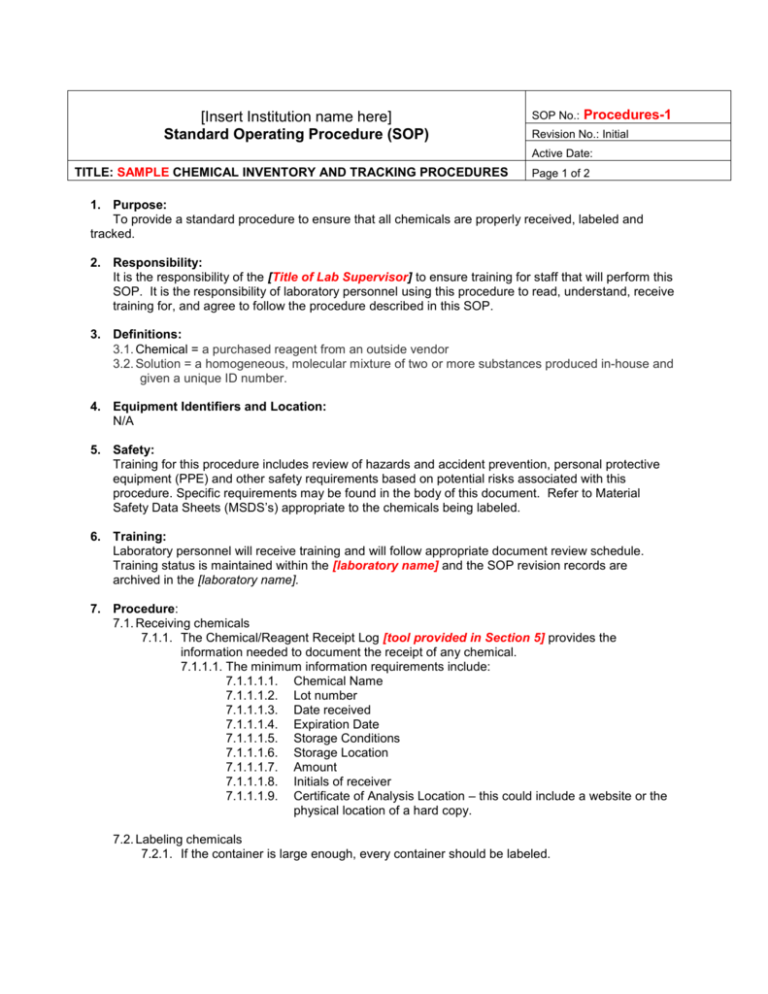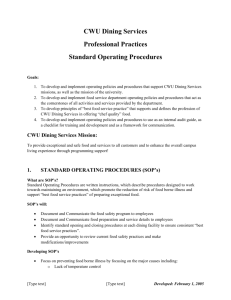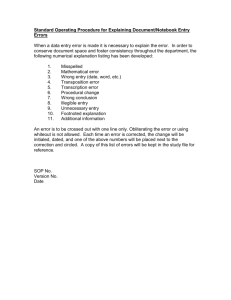Section 4 - Standard Operating Procedures
advertisement

[Insert Institution name here] Standard Operating Procedure (SOP) SOP No.: Procedures-1 Revision No.: Initial Active Date: TITLE: SAMPLE CHEMICAL INVENTORY AND TRACKING PROCEDURES Page 1 of 2 1. Purpose: To provide a standard procedure to ensure that all chemicals are properly received, labeled and tracked. 2. Responsibility: It is the responsibility of the [Title of Lab Supervisor] to ensure training for staff that will perform this SOP. It is the responsibility of laboratory personnel using this procedure to read, understand, receive training for, and agree to follow the procedure described in this SOP. 3. Definitions: 3.1. Chemical = a purchased reagent from an outside vendor 3.2. Solution = a homogeneous, molecular mixture of two or more substances produced in-house and given a unique ID number. 4. Equipment Identifiers and Location: N/A 5. Safety: Training for this procedure includes review of hazards and accident prevention, personal protective equipment (PPE) and other safety requirements based on potential risks associated with this procedure. Specific requirements may be found in the body of this document. Refer to Material Safety Data Sheets (MSDS’s) appropriate to the chemicals being labeled. 6. Training: Laboratory personnel will receive training and will follow appropriate document review schedule. Training status is maintained within the [laboratory name] and the SOP revision records are archived in the [laboratory name]. 7. Procedure: 7.1. Receiving chemicals 7.1.1. The Chemical/Reagent Receipt Log [tool provided in Section 5] provides the information needed to document the receipt of any chemical. 7.1.1.1. The minimum information requirements include: 7.1.1.1.1. Chemical Name 7.1.1.1.2. Lot number 7.1.1.1.3. Date received 7.1.1.1.4. Expiration Date 7.1.1.1.5. Storage Conditions 7.1.1.1.6. Storage Location 7.1.1.1.7. Amount 7.1.1.1.8. Initials of receiver 7.1.1.1.9. Certificate of Analysis Location – this could include a website or the physical location of a hard copy. 7.2. Labeling chemicals 7.2.1. If the container is large enough, every container should be labeled. [Insert Institution name here] Standard Operating Procedure (SOP) SOP No.: Procedures-1 Revision No.: Initial Active Date: TITLE: SAMPLE CHEMICAL INVENTORY AND TRACKING PROCEDURES Page 2 of 2 7.2.2. If the container is too small to include all necessary information, a batch of chemicals or reagents can be stored in an appropriately labeled box. Every container must have some identifier relating it to the label on the box. 7.2.3. The minimum information needed to label chemicals includes: 7.2.3.1. Safety information in the form of the National Fire Protection Association four color diamond which satisfies the OSHA Hazard Communication Standard. The diamond quadrants designate the following hazards: 7.2.3.1.1. left (blue) quadrant = health hazard with one of the following numbers: 0=normal material, 1=slightly hazardous, 2=hazardous, 3=extreme danger, 4=deadly 7.2.3.1.2. upper (red) quadrant = fire hazard flash points with one of the following numbers: 0=will not burn, 1=above 200F, 2=below 200F, 3=below 100 F, 4=below 73F 7.2.3.1.3. right (yellow) quadrant = reactivity with one of the following numbers: 0=stable, 1=unstable if heated, 2=violent chemical change, 3=shock and heat may detonate, 4=may detonate 7.2.3.1.4. bottom (white) quadrant = specific hazard with one of the following indicators: radiation hazard (universal radiation symbol), use no water (W with a horizontal line through it), corrosive (COR), alkali (ALK), acid (ACID), oxidizer (OXY) 7.2.3.2. Expiration Date 7.2.3.3. Date opened 7.3. Preparing and labeling solutions 7.3.1. Each solution should have a solution preparation record [tool provided in Section 5]. 7.3.1.1. Minimum information requirements for solution preparation record include: 7.3.1.1.1. Solution-specific information: 7.3.1.1.1.1. Solution name 7.3.1.1.1.2. Solution ID (usually date prepared and initials of preparer) 7.3.1.1.1.3. Storage information 7.3.1.1.1.4. Solution Expiration Date 7.3.1.1.2. Component (chemicals and/or reagents)-specific information: 7.3.1.1.2.1. Chemicals / solutions used 7.3.1.1.2.2. Lot number of chemicals / reagents used 7.3.1.1.2.3. Amount of chemicals / reagents used 7.3.1.1.2.4. Component Expiration Date 7.3.1.1.3. Identification of equipment used. 7.3.2.Each solution should have the minimum labeling information: 7.3.2.1. Solution name (spelled out – no abbreviations) 7.3.2.2. Solution ID 7.3.2.3. Expiration Date 7.3.2.4. Storage Information 7.4. Documenting chemical and solution use on test worksheets. 7.4.1. When documenting the chemical / solution used on test worksheets, the lot number or solution ID number of each should be recorded. 8. References: 8.1. Chemical / Reagent Receipt Log (Data-1) 9. Revision history [Insert Institution name here] Standard Operating Procedure (SOP) Title: SAMPLE LABELING REAGENTS PROCEDURE SOP No.:Procedures-2 Revision No.: Initial Active Date: Page 1 of 1 1. Purpose: The purpose of this SOP is to provide instructions on how to properly label laboratory reagents. 2. Responsibility: It is the responsibility of the [Insert Title of Laboratory Supervisor] to ensure training for staff that will perform this SOP. It is the responsibility of laboratory personnel using this procedure to read, understand, receive training for, and agree to follow the procedure described in this SOP. 3. Definitions: N/A 4. Equipment Identifiers and Location: N/A 5. Safety: 5.1 Training for this procedure includes review of hazards and accident prevention, personal Protective equipment (PPE) and other safety requirements based on potential risks associated with the methods, reagents and/or equipment used. Refer to Material Safety Data Sheets (MSDS) appropriate to the chemicals being labeled. 5.2 Safety information in the form of the National Fire Protection Association four –color diamond label which satisfies the OSHA Hazard Communication Standard. 6. Training: 6.1 Laboratory personnel will receive training and follow annual document review. Training status is maintained within the lab and the SOP revision records are archived. 7. Procedure: 7.1 All reagents and chemicals that are received need a label with the following information: 7.1.1 Date received 7.1.2 Date opened 7.1.3 Expiration date 7.1.4 Storage type 7.1.5 Inventory number (written in the ‘lot number’ area). 7.2 All reagents and chemicals that are received are then recorded on the Chemical Inventory Form for that particular reagent/chemical. All new lot numbers are assigned a new lowercase letter after the corresponding inventory number. 7.3 All solutions that are prepared need to be labeled with the following information: 7.3.1 Solution name 7.3.2 Preparation date 7.3.3 Expiration date (usually 6 months, unless stated otherwise) 7.3.4 Storage requirement 7.3.5 Preparer’s initials 7.3.6 Optional: SOP reference for which the solution is used 8. References: 8.1 Solution Preparation SOP 8.2 Chemical Inventory Form 9. Revision History: [Insert Institution name here] Standard Operating Procedure (SOP) TITLE: SAMPLE USING THE TEST METHOD SOP TEMPLATE 1. SOP No.: Procedures-3 Revision No.: Initial Active Date: Page 1 of 2 Purpose: A short statement describing the objective of the procedure. Identify the intended analyte(s) and describe the appropriate matrix or specimen for testing. Example: Quantitative measurement of testosterone concentration in canine and feline serum using a chemiluminescence immunoassay and the Siemens Immulite 1000 Analyzer. 2. Responsibility: To whom the SOP applies. Example: It is the responsibility of the [Title of Dept/Lab Supervisor] to ensure training for staff that will perform this SOP. It is the responsibility of laboratory personnel using this procedure to read, understand, receive training for, and agree to follow the procedure described in this SOP. 3. Definitions: As needed for abbreviated/acronym terms that may appear throughout the SOP. Sort alphabetically when list is complete and use bullet format or numbers to organize the material. 4. Equipment and Material: Identify associated equipment. Identify any reference standards or reference materials required. 5. Safety: Include method specific hazards in addition to general practices. Examples of content include: Training for this procedure includes review of hazards and accident prevention, personal protective equipment (PPE) and other safety requirements based on potential risks associated with the methods, reagents and/or equipment used. All biological, chemical and radioactive waste is disposed according to state, federal and [Insert Institution name] requirements. List any personal protective equipment (PPE) needed while performing this procedure. All staff should know how to locate MSDS on the Web, so ensure this is part of their training. Safety information in the form of the National Fire Protection Association four–color diamond that satisfies the OSHA Hazard Communication Standard. 6. Training: Example text: Laboratory personnel will receive training and will follow appropriate document review schedule. Training status is maintained within the [Institution or Department name]. 7. Procedure: Explain the process in sequential steps and use bullet format or numbers to organize the material. Diagram flowcharts can be used instead of text. [Insert Institution name here] Standard Operating Procedure (SOP) TITLE: SAMPLE USING THE TEST METHOD SOP TEMPLATE SOP No.: Procedures-3 Revision No.: Initial Active Date: Page 2 of 2 Include information on: Sample handling Specific conditions for sample preparation Checks to be made prior to beginning the procedure (e.g. equipment checks and calibration) Any calculations to be completed Verification steps 8. Acceptance Criteria: If acceptance criteria are not utilized, record N/A. Include information on appropriate responses if acceptance criteria are not met. Tip: Using an “if, then” sentence format can simplify this type of statement. 9. References: Examples listed below Forms with form number (which may include flow charts and recording forms or worksheets) Assay validation references and/or data recording form Reference material (text books, journal or trade publication) Equipment manual, if applicable for safety concerns or usage Commercial Kit inserts 10. Comments: (optional) 11. Revision History: Use this section when a change has been made to the SOP. Describe the change, record the date and version number, and note archival location of previous versions. HOW TO USE THIS TOOL: Create an SOP for each critical assay method, measurement technique and piece of equipment used for the project. Ensure that each person performing the procedure is trained to perform it in a standard way and follows the SOP each time they do it. Revise the SOP as needed, and maintain previous versions. WHY DO THIS? Consistent use of SOPs helps ensure that measurement methods and equipment use (with training, calibration, maintenance) generate accurate, repeatable and auditable data for the project. [Insert Institution name here] Standard Operating Procedure (SOP) TITLE: SAMPLE USING THE EQUIPMENT SOP TEMPLATE SOP No.: Procedures-4 Revision No.: Initial Active Date: Page 1 of 2 1. Purpose: Use of (include description and location of) the equipment and its associated test or function. Include laboratory equipment identification number if applicable. Examples: This SOP describes the operation of the autoclave used to decontaminate heat-stable materials. This SOP describes the operation of the Genysis (equipment id: xyz) gamma counter used in each radioimmunoassay procedure. 2. Responsibility: To whom the SOP applies. Example text: It is the responsibility of the [Title of Dept/Lab Supv] to ensure training for staff that will perform this SOP. It is the responsibility of laboratory personnel using this procedure to read, understand, receive training for, and agree to follow the procedure described in this SOP. 3. Definitions: As needed for abbreviated/acronym terms that may appear throughout the SOP. List alphabetically when list is complete and use bullet format or numbers to organize the material. 4. Equipment and Material: Identify associated equipment. Identify any reference standards or reference materials required (e.g. reference strains, reference standards for antibody). 5. Safety: Examples of content include: 5.1 Training for this procedure includes review of hazards and accident prevention, personal protective equipment (PPE) and other safety requirements based on potential risks associated with the methods, reagents and/or equipment used. All biological, chemical and radioactive waste is disposed according to state, federal and [Insert Institution name here] requirements. 5.2 All staff should know how to locate MSDS on the Web, so this must be part of their training. 5.3 Safety information in the form of the National Fire Protection Association four –color diamond which satisfies the OSHA Hazard Communication Standard. 6. Training: Example text: Laboratory personnel will receive training and will follow appropriate document review schedule. Training status is maintained within the [Institution or Department name here]. 7. Maintenance: Maintenance should include references to cleaning and other routine maintenance, and the recording of those activities in a log (paper or electronic). When applicable, refer to the manufacturer’s manual. (Check online or with sales rep for manual) If manual is not available: Visual inspections within current calibration cycle [Insert Institution name here] Standard Operating Procedure (SOP) TITLE: SAMPLE USING THE EQUIPMENT SOP TEMPLATE 8. SOP No.: Procedures-4 Revision No.: Initial Active Date: Page 2 of 2 Appropriate monitoring or testing (verification checks, alarm checks) – include pass/fail criteria Cleaning Maintenance (use relevant sections of operator’s manual for guidance) Calibration: Calibration/Standardization (use relevant sections of operator’s manual and include external vendor calibrations and pass/fail criteria) Verification and/or Validation procedures and component testing, if applicable Internal pass/fail qualifications Operation Remedial action in case of malfunction Equipment log requirements (maintenance, repair, calibration records), including equipment monitoring records If calibration records are not required (because the equipment types do not affect the quality of the results), it is acceptable to identify the exempted equipment with a statement such as: Exceptions: The following pieces of equipment usually do not require SOPs or calibration logs as they do not generate or affect resultant data and require no services other than general housekeeping and cleaning. If malfunction occurs, the item will be discarded. Vortex mixer Laboratory shakers Blenders Dishwasher Magnetic Stir plates 9. Procedure: 9.1 Each equipment SOP will contain procedure steps explaining the process in sequential steps. 9.2 Record equipment metrics in the log as directed in section 8. 10. References: Include the following: Identification of Forms (if any) on which data (maintenance, calibration) will be recorded when using this SOP. Related SOPs Manufacturer’s manual or other material Location or reference Forms Other 11. Comments: (optional) 12. Revision History: Record the change date and details. Tips for Writing Standard Operating Procedures (SOPs) Use a consistent template (header, footer, font, elements, version control) for all SOPs. Provide a title that is identifying in purpose, brief and direct. Clearly articulate the purpose of the procedure. Ensure format and number system is simple, logical and correct. Ensure that the SOPs are written in the language that is readily understood by the person performing the task. Keep sentences short, avoid ambiguity, and get to the point. List equipment, controls, reagents and other supplies if appropriate. Use simple and direct procedure steps that explain how to perform the tasks in a step-by-step manner. Use of photos, illustrations, flow charts and diagrams is recommended. Ensure that diagrams and drawings are easy to understand and are consistent with text. Clearly provide responsibility for performing or contributing to the operations cited. Attach and identify associated forms in the reference section or have them readily available for use with the procedure. If the SOP includes procedure or process acceptance criteria, provide instruction for responding to process failure, with troubleshooting steps if applicable. Define terms and abbreviations and use them consistently. Address and reference regulatory requirements (safety). Safety details should be specific to the procedure being performed. List related SOPs, forms or other guidance documents upon which the SOP is based in the reference section. Ensure that each page contains page numbers of total pages and the SOP version number. Avoid saying things twice. Refer to related documents rather than repeating material from other documents. Be careful with the use of words like 'all', 'never', 'always' and 'every.' Check for spelling errors, unnecessary spaces or pages within the document. Ensure that documents undergo periodic review and that the version number is present on each page. Ensure that there is a change approval and change communication process, and note revisions on the revision history section of the SOP. Solicit feedback from multiple SOP users to make sure that the procedures are clear and accurate prior to finalizing the version. Tips for Creating Data Forms Use a simple, descriptive title, a clear purpose, and font and font size that are easily read. Refer to relevant SOP(s) (if any) on form. Include ‘completed by’ and ‘date completed’ fields for each form.



